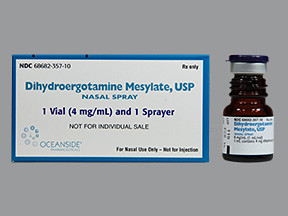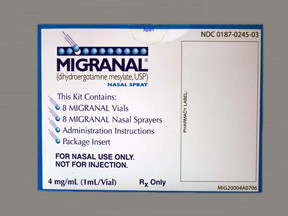DIHYDROERGOTAMINE - NASAL
PHONETIC PRONUNCIATION: (dye-HI-dro-er-GOT-uh-meen)
COMMON BRAND NAME(S): Migranal
GENERIC NAME(S): dihydroergotamine mesylate
Uses
USES: This medication is used to treat migraine headache attacks. It helps relieve headache pain and other symptoms such as sensitivity to light or sound. Prompt treatment allows you to get back to your normal routine sooner and may decrease your need for other pain medications. This medication is not used to prevent migraines from occurring. Dihydroergotamine belongs to a class of drugs known as ergot alkaloids. It may work by narrowing the blood vessels in the brain. It may also block other pain pathways in the brain.
How to use DIHYDROERGOTAMINE - NASAL
HOW TO USE: Read the Patient Information Leaflet provided by your pharmacist before you start using dihydroergotamine and each time you get a refill. If you have any questions, consult your doctor or pharmacist. Learn all preparation and usage instructions in the product package. If any of the information is unclear, consult your doctor or pharmacist. This medication comes in individual nasal spray vials. Each vial contains enough medication to treat a single migraine attack. Do not use more than 4 sprays for a single attack. Before using each nasal spray vial, prime the pump by spraying 4 times into the air, away from the face. At the first sign of a migraine, spray this medication into the nostrils. Do not inject this medication. Use 1 spray into each nostril. Do not tilt your head back, sniff through your nose, or blow your nose while spraying or immediately after. Use another spray into each nostril 15 minutes after the first sprays, or use as directed by your doctor. After using the medication, you should lie down and relax in a quiet, darkened room. The maximum number of sprays you can use for a single attack is 4 sprays (two in each nostril). You should feel some relief within 30 minutes of using this medication. The dosage is based on your medical condition and response to treatment. Ask your doctor how often you can use this medication to treat your migraine headaches. Do not increase your dose or use this drug more often or for longer than prescribed. Your condition will not improve any faster, and your risk of side effects will increase. This medication works best if it is used as the first signs of the headache occur. If you wait until the headache has worsened, the medication may not work as well. Use only as needed to treat migraine attacks when they occur. It is not meant for long-term daily use. If you have never used this medication before and you have risk factors for heart disease (see Precautions), you may need to be monitored for rare but serious side effects (such as chest pain) when you take the first dose. Your doctor may ask you to take the first dose in the office. If you also take "triptan" or other ergot medications (such as sumatriptan, methysergide), wait 24 hours before and after taking dihydroergotamine. Consult your doctor or pharmacist for more details and for advice on how to time your doses of these medications. If you are using drugs for migraine attacks on 10 or more days each month, the drugs may actually make your headaches worse (medication overuse headache). Do not use medications more often or for longer than directed. Tell your doctor if you need to use this medication more often, or if the medication is not working as well, or if your headaches get worse.
Side Effects
Precautions
Interactions
Overdose
Images

- color
- colorless
- shape
- imprint
Reviews
Warning
WARNING: This medication has rarely caused a very serious lack of blood flow to the hands and feet (peripheral ischemia) or to the brain, which could cause a stroke. The risk is increased when this medication is taken with other drugs that can affect the removal of dihydroergotamine from your body. Examples include azole antifungals (such as ketoconazole, itraconazole), boceprevir, cobicistat, mifepristone, telaprevir, certain antidepressants (such as nefazodone), macrolide antibiotics (such as clarithromycin, erythromycin, troleandomycin), HIV NNRTIs (such as delavirdine), HIV protease inhibitors (such as ritonavir, nelfinavir, indinavir), SSRIs (such as fluoxetine, paroxetine, fluvoxamine), among others.
Disclaimer
IMPORTANT: HOW TO USE THIS INFORMATION: This is a summary and does NOT have all possible information about this product. This information does not assure that this product is safe, effective, or appropriate for you. This information is not individual medical advice and does not substitute for the advice of your health care professional. Always ask your health care professional for complete information about this product and your specific health needs.

No Reviews Yet